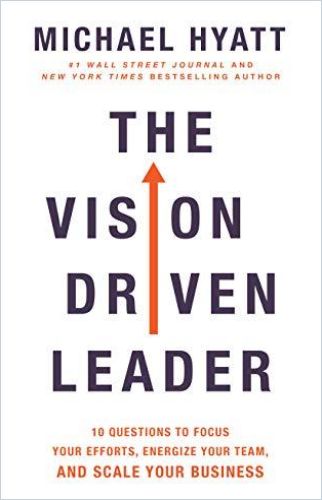Prolific author and leadership consultant Michael Hyatt offers a practical step-by-step program for creating a vision for your business and making it a reality.

Vision Quest
Leadership and management consultant and prolific author Michael Hyatt understands that you can’t lead without vision. Leaders who want to achieve the seemingly unattainable, Hyatt says, must create a vivid picture, not only of their intended destination, but of the journey toward that end. In this practical manual, Hyatt asks and answers fundamental questions that help leaders share an exciting vision and guide their teams to successful execution. If you wonder how you can clarify your goals and your team’s big, long-term objectives, while inspiring team members to follow your lead, he sets out to provide some answers.
Other leadership and self-help authors appreciate Hyatt’s approach. As Seth Godin said, “Michael Hyatt has created a fun, fast way to find your dreams and then turn them into reality.” Hyatt’s books span a broad range of self-help and leadership topics. In this one, he connects to his core ideas and offers a worthwhile program team leaders can use.
Leaders
Vision, Hyatt asserts, is the ultimate determining factor in leadership. Executives must know where they want their enterprise to go. Begin by questioning yourself to make sure your vision will win support and inspire others.
A mission defines what a business is, a vision describes where it’s going. Mission is here; vision is still out there. Mission is now; vision is next.Michael Hyatt
Therefore, Hyatt’s first question is: Are you actually a leader?
Hyatt cites Jack Welch, former chairman and CEO of GE, who made a distinction between leaders and managers. He suggested that leaders create a goal and pursue it with conviction. But managers, by contrast, he said, focus on what the team must accomplish in the immediate future to reach those targets. Hyatt dips into the obvious when he reminds you that businesses require leaders and managers.
He warns that leaders who lack foresight might abandon profitable options before they bear fruit. He offers the example of Ken Olson, founder of the Digital Equipment Corporation (DEC). Olson believed – back in 1977 – that people wouldn’t want personal computers in their homes. Hyatt describes Olson as stuck in that present; DEC did not prepare for the future, and failed.
Hyatt notes that Steve Jobs, four years before the appearance of the World Wide Web, suggested people would want to link to a “nationwide, communications network.” Hyatt’s point is that – by having a vision – Jobs saw the probability of the web and benefited from it.
Vision Script
Hyatt advises you to create a Vision Script – a document that analyzes your business in an imagined future three to five years away. He says to look through these lenses: the people you work with, your products, your marketing and sales, and what you hope to achieve – financially or otherwise.
A mission statement, Hyatt clarifies, defines a business’s identity; a Vision Script provides a route to its goal. If you feel confused about your perspective on the future, Hyatt recommends defining the factors that block your ability to see ahead. Seek counsel from people you trust, brainstorm with them, reflect on their feedback and incorporate their best advice.
Something New
Your vision must inspire your people to aim for something new. Hyatt maintains that an inspiring vision highlights what does not yet exist, can bring about major change, entails some risk within a sensible approach and focuses on your company’s end goals, not on the tactics you will use to achieve them.
Your vision highlights your destination; your strategy suggests the road to that destination. Come up with your vision first. As Hyatt points out, you can’t choose a road without knowing where you want to go.
It’s not enough to have a vision. And it’s not enough for your vision to be clear. For a vision to be effective, it must be powerful enough to shake off complacency and replace it with the motivation to take actionMichael Hyatt
Use your Vision Script to shape how you formulate strategy and hire people. He warns that if your vision is too fuzzy for your team to evaluate, it has little strategic utility.
Hyatt cites leaders with a strong sense of mission who begin with a vision, then reverse engineer it. They devise an approach to make their vision a reality, and then they set interim targets and chart what they need to do to achieve each target.
Hyatt counsels that you must convince your colleagues, senior management, the media and those employees unrelated to your project that your vision has merit. When your collaborators believe their feedback helps you shape your objectives, Hyatt contends, they will support you. He advises absorbing your collaborator’s comments slowly and making sure that all participants feel heard.
Problems
Hyatt urges you to not abandon your objectives at the first sign of trouble. Remaining steadfast in the face of challenges helps you develop your skills and retain the faith of your collaborators and customers.
Like many important things in life, creating and selling a vision begins with making a commitment. You must resolve in your own heart that you will not settle or sell out.” Michael Hyatt
Conviction and discipline enable leaders to pursue objectives well after the initial excitement of an appealing goal fades away.
Energy
Though his advice may not be groundbreaking, Hyatt brings charm and energy to wrapping fairly standard business advice and examples around a jazzy concept with a memorable name that reframes what you might normally do as a step-by-step process. He makes the typical path toward figuring out the future both clearer and simpler to implement. That is quite an accomplishment. Hyatt understands efficiency in action and in language – he writes fast, spare sentences that deliver his meaning quickly with clarity. In other words, throughout this handy manual Hyatt practices what he preaches and delivers real value.
Michael Hyatt’s other books include Free to Focus: A Total Productivity System to Achieve More by Doing Less and Your Best Year Ever: A 5-Step Plan for Achieving Your Most Important Goals. He is the co-author of Win At Work & Succeed at Life: 5 Principles to Free Yourself from the Cult of Overwork with Megan Hyatt Miller and Living Forward: A Proven Plan to Stop Drifting and Get the Life You Want with Daniel Harkavy.







